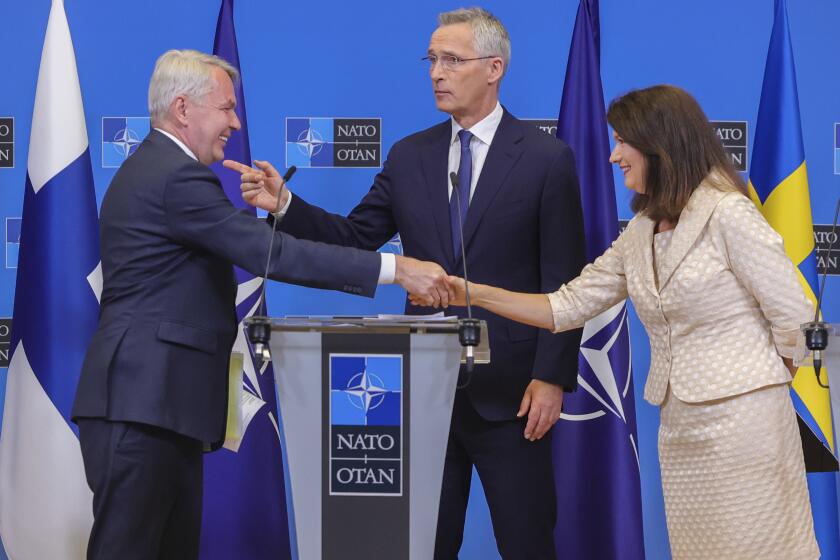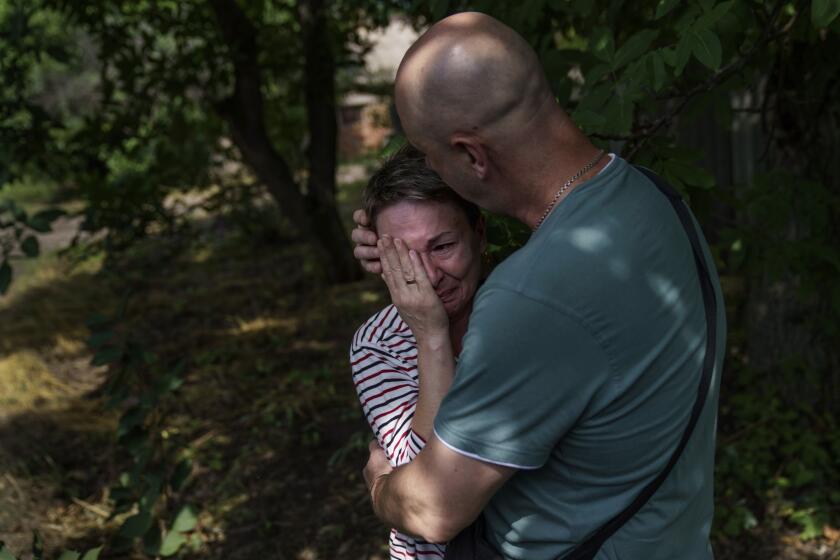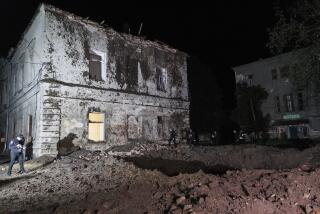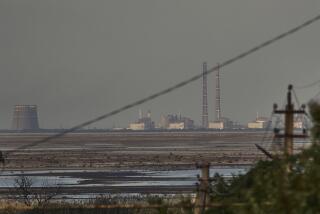Russia, Ukraine trade accusations over nuclear plant attacks

- Share via
KYIV, Ukraine — Russia and Ukraine traded accusations Monday that each side is shelling a nuclear power plant in southern Ukraine. Russia claimed that Ukrainian shelling caused a power surge and fire and forced staff to lower output from two reactors, while Ukraine has blamed Russian troops for storing weapons there.
Nuclear experts have warned that more shelling of the Zaporizhzhia nuclear power station — Europe’s largest, captured by Russia early in the war — is fraught with danger.
The Kremlin echoed that Monday, claiming that Kyiv was attacking the plant and urging Western powers to force a stop to that.
“Shelling of the territory of the nuclear plant by the Ukrainian armed forces is highly dangerous,” Kremlin spokesman Dmitry Peskov told reporters. “It’s fraught with catastrophic consequences for vast territories, for the entire Europe.”
A lack of running water in the eastern Ukrainian city of Slovyansk means that residents must fill bottles by hand at public pumps throughout the city.
Ukraine’s military intelligence spokesman, Andriy Yusov, countered that Russian forces have planted explosives at the plant to head off an expected Ukrainian counteroffensive in the region. Previously, Ukrainian officials have said Russia is launching attacks from the plant and using Ukrainian workers there as human shields.
Yusov called on Russia to “make a goodwill gesture and hand over control of the plant to an international commission and the IAEA [International Atomic Energy Agency], if not to the Ukrainian military.”
Ukraine’s ombudsman, Dmytro Lubinets, likewise urged that the United Nations, the IAEA and the international community send a delegation to “completely demilitarize the territory” and provide security guarantees to plant employees and the city where the plant is based, Enerhodar.
He accused Russia of “nuclear terrorism.”
Tymophiy, 12, lost his mother and stepfather in a hail of Russian fire and is now in the care of relatives. His diary is a record of fury and grief.
The IAEA is the U.N.’s nuclear watchdog. Its director-general, Rafael Grossi, told the Associated Press last week that the situation surrounding the Zaporizhzhia plant “is completely out of control,” and issued an urgent plea to Russia and Ukraine to allow experts to visit the complex to stabilize the situation and avoid a nuclear accident.
U.N. Secretary-General Antonio Guterres voiced support for that idea Monday, saying, “any attack to a nuclear plant is a suicidal thing.”
One expert in nuclear materials at Imperial College London said the reactor at Zaporizhzhia is modern and housed inside a heavily reinforced steel-and-concrete building designed to protect against disasters.
“As such, I do not believe there would be a high probability of a breach of the containment building, even if it was accidently struck by an explosive shell, and even less likely the reactor itself could be damaged,” said Mark Wenman at the college’s Nuclear Energy Futures.
He also said the complex’s spent fuel tanks, where the shells reportedly hit, are strong and probably don’t contain much spent fuel.
A strike last week in a separatist region of eastern Ukraine killed dozens of Ukrainian prisoners of war.
“Although it may seem worrying, and any fighting on a nuclear site would be illegal according to international law, the likelihood of a serious nuclear release is still small,” he said.
Russian Defense Ministry spokesman Lt. Gen. Igor Konashenkov said the attack Sunday caused a power surge and smoke, triggering an emergency shutdown. Fire teams extinguished flames, and the plant’s personnel lowered the output of reactors No. 5 and No. 6 to 500 megawatts, he said.
The head of the Ukrainian company operating the plant said all but one power line connecting it to Ukraine’s energy system had been destroyed. Petro Kotin, head of the Ukrainian state corporation Eherhoatom, blamed Russian shelling and said a blackout would be “very unsafe for such a nuclear facility.”
As fighting continued on the front lines of the war, the United States on Monday pledged another $1 billion in military aid for Ukraine. It would be the biggest delivery yet of rockets, ammunition and other arms straight from U.S. Department of Defense stocks for Ukrainian forces.
The latest announcement brings total U.S. security assistance committed to Ukraine by the Biden administration to $9.1 billion since Russian troops invaded on Feb. 24.
U.S. senators delivered overwhelming bipartisan approval to NATO membership for Finland and Sweden.
Ukraine’s presidential office said the Russians had shelled seven Ukrainian regions over the previous 24 hours, killing five people. Among the targets, it said, was Nikopol, a city just across the Dnieper River from the Zaporizhzhia nuclear plant. Gas pipelines, plumbing and power lines were no longer functioning there, leaving thousands of people without electricity.
Russian rockets and artillery also hit eight municipalities in the northern Sumy region on Monday, killing one person, authorities there said.
Ukrainian forces struck Russian-controlled areas in the south, officials there said, including the strategic Antonivskiy bridge in the southern city of Kherson. An artery for Russian military supplies, the bridge has been closed in recent weeks because of earlier shelling. Plans to reopen it on Wednesday were now shelved, said Kirill Stremousov, deputy head of the Moscow-appointed administration of the Kherson region.
News Alerts
Get breaking news, investigations, analysis and more signature journalism from the Los Angeles Times in your inbox.
You may occasionally receive promotional content from the Los Angeles Times.
Meanwhile, one of the ships that left Ukraine on Friday under a deal to unblock grain supplies and stave off a global food crisis arrived in Turkey, the first loaded vessel to reach its destination. The Turkey-flagged Polarnet, laden with 12,000 tons of corn, docked at the port of Derince.
“This sends a message of hope to every family in the Middle East, Africa, and Asia: Ukraine won’t abandon you,” Ukrainian Foreign Minister Dmytro Kuleba tweeted. “If Russia sticks to its obligations, the ‘grain corridor’ will keep maintaining global food security.”
Twelve ships have now been authorized to sail under the grain deal between Ukraine and Russia, which was brokered by Turkey and the United Nations — 10 outbound and two inbound. Some 322,000 metric tons of agricultural products have left Ukrainian ports, the bulk of it corn but also sunflower oil and soya.
Hundreds of evacuees have left Ukraine’s Donetsk region days after the Ukrainian government issued an order to evacuate, though some refuse.
Four ships that left Ukraine on Sunday were expected to anchor near Istanbul on Monday evening for inspection Tuesday to make sure they are carrying only food items.
The first cargo ship to leave Ukraine, the Sierra Leone-flagged Razoni, which left Odesa on Aug. 1, hit a snag with delivery, however. It was heading for Lebanon with 26,000 metric tons of corn for chicken feed, but the corn’s buyer in Lebanon refused to accept the cargo, since it was delivered so much later than its contract, Ukraine’s embassy in Beirut said.
Kareem Chehayeb in Beirut, Mehmet Guzel in Derince, Turkey, and Andrew Wilks in Istanbul contributed.
More to Read
Sign up for Essential California
The most important California stories and recommendations in your inbox every morning.
You may occasionally receive promotional content from the Los Angeles Times.


















